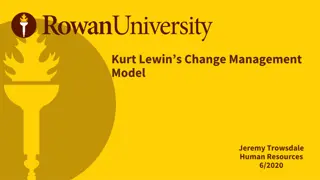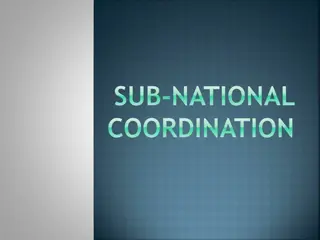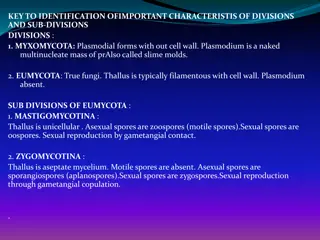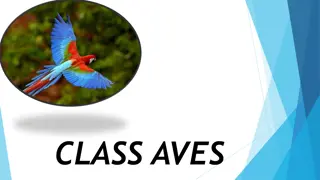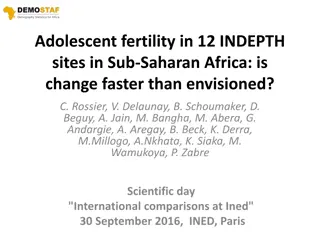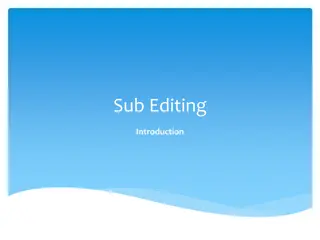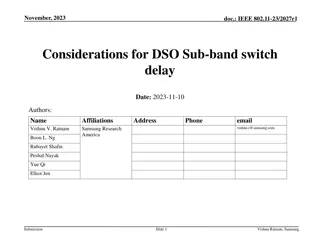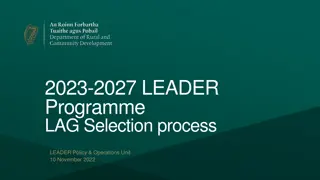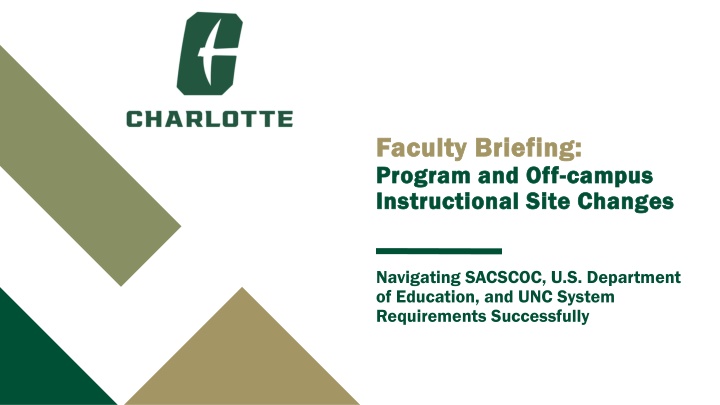
Navigating Program and Off-campus Site Changes Successfully
This briefing covers the processes involved in implementing program and off-campus instructional site changes while adhering to SACSCOC, U.S. Department of Education, and UNC System requirements. It includes details on review and approval processes, new degree program procedures, and steps for getting authorization and establishing new programs within the university system.
Download Presentation

Please find below an Image/Link to download the presentation.
The content on the website is provided AS IS for your information and personal use only. It may not be sold, licensed, or shared on other websites without obtaining consent from the author. If you encounter any issues during the download, it is possible that the publisher has removed the file from their server.
You are allowed to download the files provided on this website for personal or commercial use, subject to the condition that they are used lawfully. All files are the property of their respective owners.
The content on the website is provided AS IS for your information and personal use only. It may not be sold, licensed, or shared on other websites without obtaining consent from the author.
E N D
Presentation Transcript
Faculty Briefing: Faculty Briefing: Program and Off Program and Off- -campus Instructional Site Changes Instructional Site Changes campus Navigating SACSCOC, U.S. Department of Education, and UNC System Requirements Successfully
Review and Approval Processes Substantive Change Review 2
Review and Approval: University and UNC System New degree program procedures Request for Preliminary Authorization (formerly Letter of Intent ) Request for Preliminary Authorization (formerly Letter of Intent ) 1. Department(s) proposes program to appropriate Dean. 2. Dean consults with the Provost and seeks authorization to proceed with Request for Preliminary Authorization. 3. Dean consults with the Assistant Provost to schedule a 90-minute Kick-Off Meeting. 4. Department(s)/program(s) drafts and uploads a New Degree Program - Part One: Request for Preliminary Authorization form to Curriculog. These addendums should also be included: a) Substantive Change Planning Questionnaire and b) UNC System Academic Program Planning Financial Worksheet. Substantive Change Review 3
Review and Approval: University and UNC System (cont.) New degree program procedures (cont.) Request for Preliminary Authorization (formerly Letter of Intent ) Request for Preliminary Authorization (formerly Letter of Intent ) (cont.) (cont.) Note: Note: If the proposed program includes online and/or off-campus delivery, Program Form 4: Program Delivery should also be completed within Curriculog. 5. Within Curriculog, the Request for Preliminary Authorization is routed to: Department Chair(s), Dean(s), Office of Assessment, Dean of the Graduate School (if applicable), and the Graduate Council or Undergraduate Course and Curriculum Committee, as appropriate. 6. Following review by the Graduate Council/Undergraduate Course and Curriculum Committee, the proposal is routed via Curriculog to the Faculty President for notification and to the Provost and Office of Academic Affairs for review. Substantive Change Review 4
Review and Approval: University and UNC System (cont.) New degree program procedures (cont.) Request to Establish Request to Establish Draft and upload the Request to Establish form Complete Student Learning Outcomes Assessment Plan If needed, update the UNC System Academic Program Planning Financial Worksheet If SACSCOC Prospectus is required (see Substantive Change Planning Questionnaire step in Part I: Request for Preliminary Authorization procedure), submit Faculty Roster form as part of Request to Establish. Within Curriculog, the Request to Establish is routed through the faculty governance review process with notification to the Assistant Provost. Following Faculty Council approval, the proposal is routed via Curriculog to the Provost and Office of Academic Affairs for review. Substantive Change Review 5
Review and Approval: University and UNC System (cont.) Other program procedures Adding a new method of delivery to an existing program Adding a new method of delivery to an existing program Request to Deliver Request to Deliver Complete Curriculog Program Form 4: Program Delivery (for changing how or where a program is delivered) Adding online, site Adding online, site- -based, or off based, or off- -campus delivery to an existing degree program campus delivery to an existing degree program Department(s) prepares the Request to Deliver and the Academic Program Planning Financial Worksheet and submits via Curriculog using the Program Delivery Form. Closing a program, site, and/or delivery method Closing a program, site, and/or delivery method Request to Discontinue Request to Discontinue Complete Curriculog Program Form 1: Program Revision or Inactivation Substantive Change Review 6
Question: Question: Why is SACSCOC interested in changes occurring Why is SACSCOC interested in changes occurring at an already accredited institution? at an already accredited institution? Changes must align with the institutional mission Changes must align with the institutional mission Changes must have sufficient resources Changes must have sufficient resources Educational practices must be sound Educational practices must be sound Substantive Change Review 7
Question: Question: What is a substantive change? What is a substantive change? "A substantive change is a significant "A substantive change is a significant modification or expansion of the nature and modification or expansion of the nature and scope of an accredited institution. Substantive scope of an accredited institution. Substantive change includes high change includes high- -impact, high impact, high- -risk changes and changes that can impact the changes and changes that can impact the quality of educational programs and services." quality of educational programs and services." risk SACSCOC Substantive Change Policy and Procedures (page 2, paragraph 2) SACSCOC Substantive Change Policy and Procedures (page 2, paragraph 2) Substantive Change Review 8
Question: Question: What is a substantive change? What is a substantive change? Major change examples Major change examples (SACSCOC approval required) New degree or certificate program with 50% or more new New degree or certificate program with 50% or more new course content course content New off New off- -site with 50% or more of program credits site with 50% or more of program credits Increasing or decreasing the program s number of credit Increasing or decreasing the program s number of credit hours by 25% or more AND students' expected time to hours by 25% or more AND students' expected time to completion increases or decreases by more than one completion increases or decreases by more than one term or its equivalent or comparable measure. term or its equivalent or comparable measure. Dual or joint degree (non Dual or joint degree (non- -SACSCOC partner) SACSCOC partner) Closing a program, site, or program at a site Closing a program, site, or program at a site Substantive Change Review 9
Question: Question: What is a substantive change? What is a substantive change? Minor change examples Minor change examples (SACSCOC notification required) New degree or certificate program using existing course New degree or certificate program using existing course content or 25 content or 25- -49% new content 49% new content New off New off- -site location delivering 25 site location delivering 25- -49% of program credit hours hours 49% of program credit Adding a method of instructional delivery to an existing Adding a method of instructional delivery to an existing program when 50% or more of the program is delivered by program when 50% or more of the program is delivered by more than one method: more than one method: competency competency- -based education, based education, distance education, and distance education, and face face- -to to- -face instruction. face instruction. Substantive Change Review 10
Review and Approval: SACSCOC Major changes require submission to SACSCOC and approval of a written prospectus Major changes require submission to SACSCOC and approval of a written prospectus Helpful Resources: Crosswalks from Request for Preliminary Authorization and Request to Establish to SACSCOC Prospectus Prospectus guide and examples Substantive Change Planning Questionnaire Substantive Change Checklist Substantive Change PowerPoint Presentation Submission process is facilitated and documented via workflow in Curriculog Substantive Change Review 11
Review and Approval: Department of Education U.S. Department of Education (USDOE) approval follows SACSCOC U.S. Department of Education (USDOE) approval follows SACSCOC approval/notification approval/notification Submission process is facilitated and documented via workflow in Curriculog Office of Financial Aid will provide notification to USDOE for: A stand-alone certificate program that is one academic year and leads to gainful employment An off-campus site that offers 50% or more of a degree program Office of Financial Aid will document approval Substantive Change Review 12
How long will it take? How long will it take? Campus and Campus and UNC System UNC System Approval Approval USDOE USDOE Approval Approval Total Time Total Time SACSCOC SACSCOC Prior Approval Prior Approval New degree or certificate program (50% or more new content) 1 to 2+ years 6 to 11 months 3 to 4 months 2 to 3+ years New off-site location offering 50% or more of total program credit hours 1 year 6 to 11 months 3 to 4 months 1 to 2+ years Dual or joint degree 1 to 2 years 6 months 3 to 4 months 2 to 3+ years Increasing/decreasing the number of credit hours and expected time to completion 1+ year 2 to 6 months 6 months 3 to 4 months Substantive Change Review 13
How long will it take? How long will it take? Campus and Campus and UNC System UNC System Approval Approval USDOE USDOE Approval Approval Total Time Total Time SACSCOC SACSCOC Prior Approval Prior Approval Closing a degree or certificate program 2 to 6 months 6 months 3 to 4 months 1 to 2 years New degree or certificate program (25-49% new credit hours) N/A 1 to 2+ years 3 to 4 months 2+ years Notification Only New off-site location offering 25% to 49% of total program credit hours N/A 2 to 6 months N/A <1 year Notification Only Adding a method of instructional delivery to an existing program N/A 2 to 6 months 3 to 4 months <1 year Notification Only Substantive Change Review 14
Review and Approval: Other Timing Considerations The timeline begins when the Request for Preliminary Authorization is submitted to The timeline begins when the Request for Preliminary Authorization is submitted to the System Office and does not take into account other factors such as: the System Office and does not take into account other factors such as: The Provost and Chancellor need to approve the program to go forward The need for availability in our queue at the UNC System Office Course development/approval The time it takes the unit to discuss, plan, draft, and revise the proposal The time it takes the Dean, Provost, and Chancellor to review and comment on the proposal Academic year and summer break implications for faculty governance and Board of Governors review Type of SACSCOC Review and deadlines (Full Board of Trustees vs. Executive Council of the Board of Trustees) Substantive Change Review 15
Review and Approval: Other Timing Considerations (cont.) Distance Education Course/program modality Course/program modality DE will create an online course development schedule based on internal capacity All off-site activities must be approved by the UNC System Office Off-site locations must be reviewed and approved by DE Recruitment and Enrollment Advertising and marketing Recruitment Application processes Enrollment Substantive Change Review 16
Website Resources Website Resources Request for Preliminary Authorization Office of Assessment and Accreditation https://assessment.charlotte.edu https://assessment.charlotte.edu https://assessment.charlotte.edu/accreditation/sacscoc/ https://assessment.charlotte.edu/accreditation/sacscoc/ substantive substantive- -change change https://provost.charlotte.edu/policies https://provost.charlotte.edu/policies- -procedures/academic procedures/new procedures/new- -degree degree- -programs programs- -part procedures/academic- -policies part- -i i policies- -and and- - Request to Establish https://provost.charlotte.edu/policies https://provost.charlotte.edu/policies- -procedures/academic and and- -procedures/new procedures/new- -degree degree- -programs procedures/academic- -policies programs- -part part- -ii ii- -request request- -establish policies- - Academic Program Planning and Authorization https://provost.charlotte.edu/curriculum https://provost.charlotte.edu/curriculum- -catalogs/academic program program- -planning planning- -and and- -authorization authorization establish catalogs/academic- - Curriculog https://charlotte.curriculog.com/ https://charlotte.curriculog.com/ Substantive Change Review 17
Personnel Resources Personnel Resources Christine Robinson Assistant Provost for Institutional Effectiveness and Analytics Assistant Provost for Institutional Effectiveness and Analytics SACSCOC Accreditation Liaison for UNC Charlotte CRobinson@charlotte.edu CRobinson@charlotte.edu Steve Carter Associate Director, Strategy Implementation & Reporting Associate Director, Strategy Implementation & Reporting Online and off-site program approval and compliance liaison SCarte79@charlotte.edu SCarte79@charlotte.edu Leslie R. Zenk Assistant Provost Assistant Provost and Campus Program Coordinator for UNC Charlotte and UNC System Office LZenk@charlotte.edu LZenk@charlotte.edu Shanna Coles Associate Director, Program Development & Learner Solutions Associate Director, Program Development & Learner Solutions School of Professional Studies ShannaColes@charlotte.edu ShannaColes@charlotte.edu Johnna Watson Associate Dean, Graduate School Associate Dean, Graduate School Resource for graduate programs JWWatson@charlotte.edu JWWatson@charlotte.edu 18 Annual Review March 18, 2025 Substantive Change Review 18
Questions? Questions? Think years, not months. We look forward to working with you. Substantive Change Review 19




